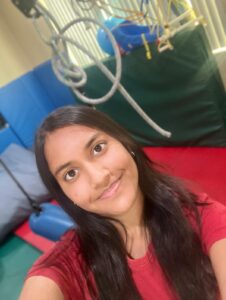Week 10- Reflection on my Research Journey
Hello everyone and welcome to week 10 of blog posts! In this post, I want to reflect on my research experience at Sunrise Therapy Services.
I started shadowing at this clinic last summer to learn more about the field of occupational therapy. I got to know some of the other therapists in the office and met such wonderful kids. Working with kids has always been something I found to be inspiring because they are such curious and resilient individuals. They find joy in the simple things, and this is the kind of perspective that I have started to embrace myself.
Throughout my research experience, I gained a deeper understanding of the realities of working with children in a therapeutic setting. While incredibly rewarding, the work also tested my patience, especially when navigating scheduling conflicts, cancellations, or moments when a child struggled to engage. These challenges only reinforced the importance of being flexible, empathetic, and persistent in this field. My research highlighted the importance of collaboration and consistency in driving long-term success for clients, offering practical insights to enhance both therapeutic practices and client engagement. The findings highlighted how personalized, team-oriented approaches not only support goal achievement but also foster stronger relationships. Drawing from my time shadowing and volunteering in a therapy clinic, I focused on how involving families in the goal-setting process could better align treatment with the client’s needs and motivations. Prior research supports this, emphasizing that “occupational therapists from all settings should adopt collaborative practice to facilitate skill transfer to family routines” (Lage et al., 2024). This ensures that clients are consistent in achieving their goals even in the absence of scheduled therapy sessions. With my study, I could potentially offer practical recommendations for new therapists entering the world of healthcare, emphasizing the significance of collaboration in goal setting as a step towards resolving the gaps in clinician-patient communication.
Overall, conducting this study has definitely been a journey. I quickly learned that research doesn’t always follow a predictable path. But more than anything, this experience has taught me to become more adaptable and patient as a person. My passion for the field of occupational therapy has only deepened and I plan to continue volunteering at the clinic, making fun memories with the kids. My final research paper will give others the opportunity to learn more about collaborative goal setting and the GAS method in the field of OT at their own pace if they are interested in a hands on, healthcare profession like this. Here are some pictures of me at the clinic:


Thank you to everyone who followed along my research journey and I hope that you learned more about the field of occupational therapy. I am so grateful that I was able to do my research at this clinic where I had already established such wonderful connections. And a huge thank you to Ms. Sheila, Ms. Bennett, and Ms. Holtzman who have been so supportive throughout this research process!

Comments:
All viewpoints are welcome but profane, threatening, disrespectful, or harassing comments will not be tolerated and are subject to moderation up to, and including, full deletion.